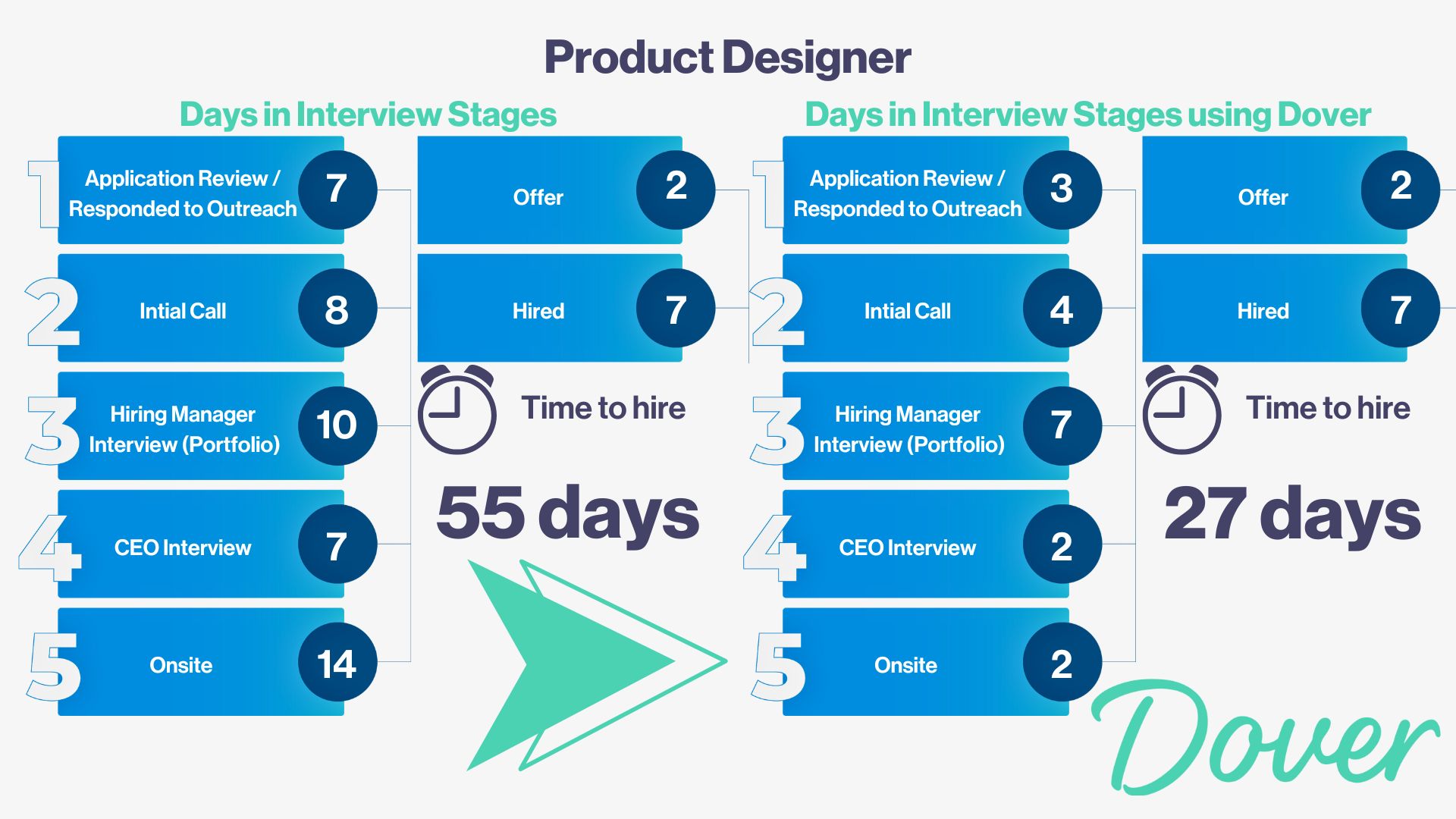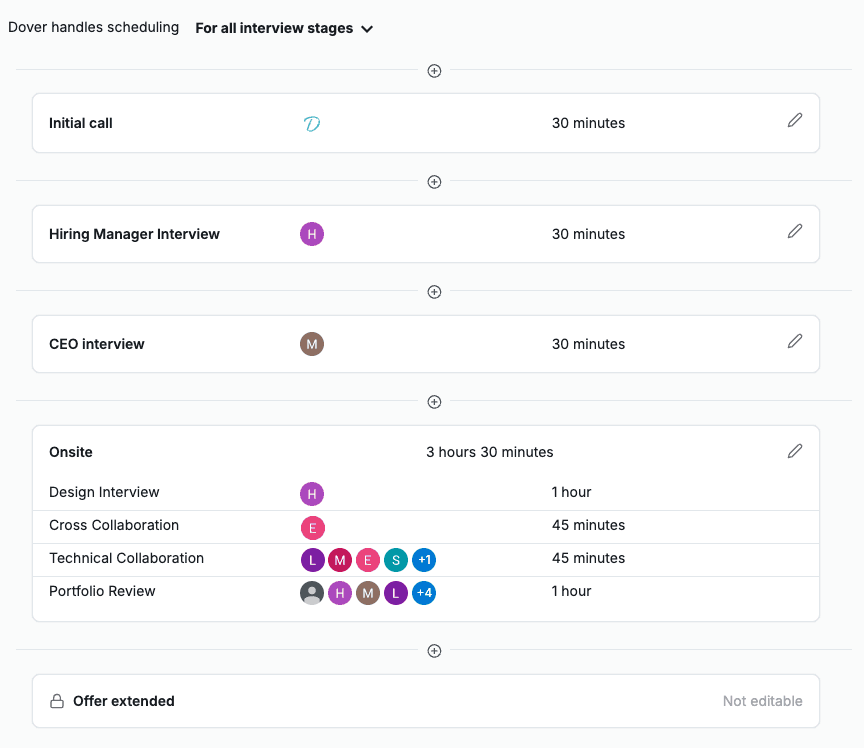Strategies for streamlining hiring and reducing time-to-hire at your startup

Gabrielle DeMers
Customer Success Manager
April 17, 2024
•
7 min
What is time-to-hire?
Time-to-hire measures the total number of days after engaging with a candidate until when they accept an offer.
Time-to-hire = The day candidate accepts a job offer - the day they applied to (or were contacted about) the open job
According to LinkedIn, the average time-to-hire rate across industries in 2023 was 44 days. It’s important to understand that time-to-hire should be benchmarked against similar roles at similar companies. For example, contract roles may take significantly less time to fill because their interview plan does not need to be as thorough due to the part-time nature of the role.
The best way to reduce time-to-hire is to streamline your interview plan. Building a faster hiring process is important not only to save both your internal recruiting team's and candidates’ valuable time, it allows your team to quickly identify and hire a suitable candidate who's a good fit for the position.
What's the difference between time-to-hire and time-to-fill?
Time-to-hire is not to be confused with time-to-fill, which measures the time period (total number of days) between when a job opening is published to a job offer being accepted.
Both recruiting metrics are valuable for companies to realistically understand how long it takes to fill a open job against industry benchmarks. Underestimating how long it will take to fill a position can be detrimental for a company’s growth.
What is time-to-fill?
According to LinkedIn, the actual time-to-fill rate was industry dependent. For example, in 2023, the energy and defense industries had the longest time-to-hire at 67 days followed by investment banking which took up to 60 days. The retail and consumer industries took the least time to fill roles, while tech and media took about 20 days to hire.
It’s important to note that industry benchmarks, while helpful, are not role-specific. For example, roles in tech like customer support may only take 10 days to fill while a senior software engineer role may take 60 days.
Identify bottlenecks in your hiring process
As an exercise, write down your interview plan for some of your recently-filled positions. Calculate on average how long candidates spend in each interview stage. Be sure to track how long it takes from when an applicant applies to your position as well as when a suitable candidate responds as interested to your outreach. Measuring the time candidates spend in each stage and why is valuable information in improving your hiring process.
How long does it take for candidates to move through your interview stages?
One you’ve written down your interview plan and calculated how long candidates spend in each stage on average, you’ll know how long it takes for candidates to move through your entire interview plan for a given role. For each candidate you’ve hired, you can calculate the time-to-hire. You may notice these numbers are different; hired candidates may have been fast-tracked.

💡Be sure to track how long it takes from when an applicant applies to your position as well as when a suitable candidate responds as interested to your outreach. Measuring the time candidates spend in each stage and why is valuable information in improving your hiring process.
The time-to-hire for the Product Designer example above was 55 days — that's a long time! A lot can happen over a 55 day time period…the scope of the role may have shifted depending on business needs or the perfect candidate may have received competing offers and withdrawn. At Dover, for every day a candidate waits to hear back about next steps, we see a 5% reduction in their likelihood to schedule an interview. That means that if 10 candidates wait a week to hear about next steps, you’ve already lost 3 of them due to the delays in your process.
So, how can we speed things up?
Understand why your hiring process is slow
Let's look at one of the interview steps to see why it takes so long. In the example above, it took 10 days to move a candidate from a Hiring Manager Interview to the CEO Interview. Why?
Most hiring managers will complete the interview, then reflect on the candidate for a day or two before deciding to move forward.
The hiring manager will then email the candidate to hand them off to the CEO interview and ask for their availability. The candidate will likely take a day or two to respond.
Since both the CEO and the candidate are busy, there is likely some scheduling back and forth. Since both are busy, they schedule the interview a week out in advance.
That's a lot of lost time!
💡 At Dover, we recommend informing candidates about next steps during an interview or immediately after their interview. We also suggest including a scheduling link for candidates to book their next round to cut down on the back-and-forth emails.
Since so much of recruiting is operational, using technology to help with hiring is essential, especially if you're hiring for multiple roles simultaneously.
Utilize an applicant tracking system (ATS)
Applicant tracking systems (ATS) are a must for companies looking to hire. An applicant tracking system is a computer software program that manages the hiring process, collecting and sorting through applications and tracking candidate progress throughout the hiring process.
Dover's free ATS allows you to track all of your candidates in one place from application to offer and to leverage AI applicant sorting to fast-track the most qualified candidates.
Automate communicating with and scheduling candidates
Remember the Product Designer whose time-to-hire was 55 days? In that example, emailing back and forth with candidates to schedule interviews created significant delays.

At Dover, we offer scheduling tools and automations to significantly decrease your time-to-hire. For the Product Designer example, using Dover could have reduced the time-to-hire from 55 days to 27 days.
Streamline recruiting and reduce time-to-hire using Dover
Sort and filter applicants quickly
Dover posts your open position on multiple job boards. When job seekers apply to your job post, Dover's AI applicant sorting shows you good candidates for the position. You can quickly review ranked applicants and bulk reject and politely email those applicants who do not match your job description. Review and send an interview scheduling email to qualified applicants with the click of a button.

Create interview plans
Creating a standard interview plan that all candidates follow is an important way to fairly assess candidates.

Ideally, interview plans should only be as long as is necessary to properly evaluate whether a candidate is a good fit for the role. Too many stages will increase time-to-hire and may result in candidates dropping off. Too few stages and neither the hiring team nor the candidate can determine if they are a good fit for the role. Ad Dover, we recommend a hard cap of five interview stages including any assessments like take home assignments. Anything longer than five interview stages will result in significant drop-off rates.
Create interview rubrics to quickly & fairly evaluate candidates
A rigorous interview process is one that asks standard questions to all candidates and scores their answers based on agreed-upon criteria. In Dover, we make it easy for the hiring team to create interview feedback forms for each interview stage so that hiring teams can determine whether to advance or reject a candidate based on interviewer notes.

Make candidate decisions fast
After candidates complete an interview, the interviewer should know pretty quickly whether the candidate should be advanced or not. Hiring teams can review interview notes and make decisions about candidates directly in Slack or in our web app.


Automate email communications with email templates
With Dover, you can create interview scheduling templates with candidate-specific scheduling links so that candidates can book a time with the interviewer based on their availability and interview preferences. As soon as a candidate is approved, a custom scheduling email will be sent for them to book time on the interviewer’s calendar. This significantly speeds things up by cutting down on the back and forth emails between the hiring team and candidates.

Conduct virtual interviews to expedite interviewing
We live in a remote / work from home culture and most interview stages can be conducted virtually, even for in-person roles. At Dover, most of our customers conduct video interviews — primarily on Zoom or Google Meet — with candidates. Some of our customers do fly candidates out for the final interview stage, especially for in-person roles, but conducting interviews virtually saves both time and money.
Communication is key for any hiring team. Be sure to align with your hiring team and communicate clearly with candidates.
Establish clear communication channels between hiring managers and recruiters
At the start of hiring for a role, before a job description is even created or the role is posted publicly, it’s important to align on what a great candidate looks like, what the day-to-day of the role will be, and what the logistics of the role will be - location requirements, visa requirements, compensation, etc.
Once candidates have applied, it’s important to keep communication open among the hiring team to quickly identify if the candidates align with what you’re targeting. Sometimes in the middle of hiring, role expectations or candidate criteria may shift, or you may discover that you’re not getting enough information from your interviews. In these situations, it is important to be able to quickly respond and adapt.
Provide timely feedback to candidates
It’s important to provide a great candidate experience given how much time candidates have invested in interviewing for your role. If you’re rejecting a candidate, if they ask why they didn’t move forward, the best practice is to share some feedback so that they can improve in their next interviews. If there is a significant delay in responding to candidates who are mid-process, it’s best practice to reach out with an update — even if you’re in late stages with other candidates.
Create a successful job offer strategy
Once you’ve decided to make an offer, have a plan in place. It could be making an informal email offer, then a phone call with Chief of Staff, and finally emailing a formal offer letter. Have documents like an offer letter template ready to go and fill in the details like candidate info & compensation after the verbal offer has been accepted.
Conduct background and reference checks
If your HR team does not do background checks or reference checks or your company doesn’t have HR, you can use a company like Checkr. You can request all the information from the candidate after the completion of their final interview or when you verbally give them an offer.
Standardize offer letters and contracts
How you making an offer to a candidate is important and can make a difference in whether or not they accept. Typically, an HR team has an offer letter template and benefits package ready. The hiring team can align on the compensation range at the beginning of the search so that there are very few delays at the offer stage.
Companies should anticipate that candidates may push back on compensation, so it’s best practice to have benchmark information available should candidates ask for more compensation at this stage.
Measure success using recruiting metrics
Track key recruitment metrics such as time-to-fill and time-to-hire
Once you have hired your candidate, perform an analysis so that you can iterate for your company’s next role.
Analyze the effectiveness of your hiring process
Look at your careers page, your job post, your application, your interview plan, and your selection criteria. Seek input and feedback from your hiring team and job seekers to gain valuable insights into what worked and what needs work. For example, did most candidates withdraw after a take home assignment? Perhaps that assignment was too onerous.
Make adjustments as needed to further streamline the hiring process
Once you’ve done a thorough audit of your recruiting process, identify areas for improvement. A key performance indicator like time-to-hire provides valuable insight into whether or not your recruitment process is working well. Implement changes that will lead to faster time-to-hire for the best candidate for your next new job opening.
Running a streamlined recruitment process significantly reduces your time-to-hire and increases the overall candidate experience. Great hiring teams continuously improve and iterate based on what’s working and what’s not.
Table of contents

